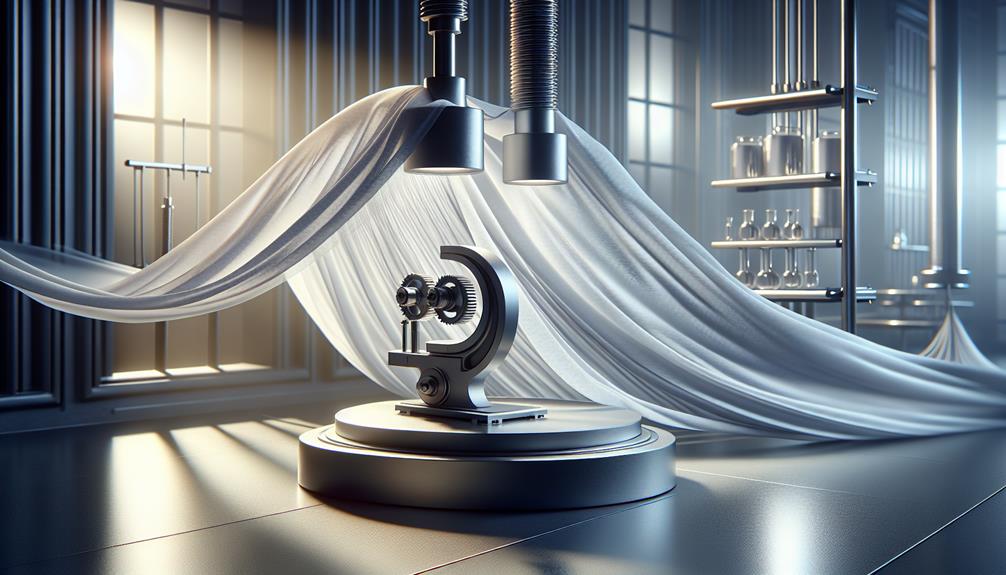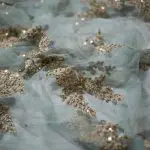I've often wondered about how sturdy chiffon really is, considering its delicate, sheer look. Turns out, it's more rugged than you might think! Chiffon can be made from silk, nylon, or polyester. Silk chiffon is luxurious and beautiful but a bit delicate and needs gentle care. Polyester chiffon, on the other hand, is tougher, great for regular wear, and easier to handle. So, durability really depends on the type of chiffon. Proper care is crucial too—gentle washing and avoiding harsh sunlight can make it last longer. There's quite a bit more to uncover about keeping chiffon in tip-top shape!
Table of Contents
Key Takeaways
- Chiffon varies in durability; silk chiffon is delicate, while polyester chiffon is more resistant to wear and tear.
- The fabric's sheer and lightweight nature makes it prone to snagging and pilling, reducing its lifespan.
- Polyester chiffon holds up better in washes and resists shrinking and wrinkling, unlike silk chiffon.
- Proper care, including gentle hand washing and avoiding harsh wringing, can significantly extend chiffon's life.
- Environmental factors like sunlight, humidity, and air quality can affect chiffon's durability, leading to faster degradation.
Understanding Chiffon Fabric
Chiffon's lightweight and sheer qualities make it uniquely challenging yet rewarding to work with. As I delve into its intricacies, I've noticed how its delicate appearance belies a surprisingly tough character. Chiffon is essentially a weaving of fine threads, typically silk, nylon, or polyester. This creates a fabric that's both soft and airy, ideal for creating elegant, flowy garments.
Handling chiffon requires a gentle touch and a bit of patience. It's slippery, so cutting and sewing demand precision. I always make sure my scissors are super sharp and I use plenty of pins. Sewing needs a fine needle and a lot of concentration. Despite these challenges, mastering chiffon has been a fulfilling journey. It's all about the right tools and techniques.
In terms of care, chiffon can be tricky. It's best to hand wash or use a gentle cycle with cool water to avoid damaging the fibers. And oh, always use a mild detergent. Ironing should be done on a low setting, and I prefer using a pressing cloth to protect the delicate fabric.
Understanding these characteristics and proper care techniques really help in extending the life of chiffon garments, making all the effort worth it.
Types of Chiffon Explained
Let's talk about the different types of chiffon.
We'll look at how silk chiffon and polyester chiffon differ, and what makes each unique.
Then, I'll explain a bit about how chiffon is woven and why that matters for its durability.
Silk Chiffon Characteristics
Silk chiffon, a type often favored for its sheer elegance, combines resilience with a delicate appearance. I've always been drawn to its luxurious feel and the way it drapes so beautifully. Whether you're crafting a flowing evening gown or a simple scarf, silk chiffon adds a touch of sophistication.
Here's a quick table to break down its key characteristics:
| Feature | Description | Benefit |
|---|---|---|
| Weight | Light | Enhances fluidity and movement |
| Texture | Slightly rough, natural feel | Offers a unique tactile quality |
| Durability | More delicate than synthetic variants | Requires careful handling |
| Appearance | Sheer, translucent | Ideal for layered looks |
Polyester Chiffon Qualities
Polyester chiffon, while less luxurious than silk, offers impressive durability and affordability. It's a fantastic option for those of us who need a fabric that stands up to wear and tear while still looking great. Because it's synthetic, it resists shrinking and wrinkling more than silk. This makes it a go-to for everyday outfits and practical fashion choices.
I appreciate how it maintains its color and texture through washes, and it's generally easier to care for than silk. You'll find it dries quickly, which is super handy if you're always on the go. Polyester chiffon isn't just tough; it's also versatile, making it perfect for a variety of garments, from blouses to scarves.
Chiffon Weaving Techniques
Exploring the different weaving techniques of chiffon reveals why this fabric is so versatile and beloved in fashion. Chiffon's main charm is its light, airy feel, which comes from a plain weave of alternating S- and Z-twist crepe yarns. This method allows the fabric to have a slight puckering in different directions, giving it a bit of stretch and a slightly rough feel.
Silk and synthetic chiffon differ mainly in the type of yarn used, but both follow the same basic weaving approach. Mastering the understanding of these techniques allows designers to manipulate the fabric better, enhancing its natural drape and flow. Knowing this helps me choose the right type of chiffon for my projects, ensuring durability and elegance.
Factors Affecting Chiffon Durability
When I think about what makes chiffon last, a few key factors stand out.
First, the type of fibers used in the fabric can really change how it holds up over time.
Also, how you care for chiffon and the environment it's in play big roles in its longevity.
Fabric Composition Variability
Chiffon's durability varies significantly depending on its material composition, whether it's silk, polyester, or a blend. Here's how these materials stack up:
- Silk Chiffon: It's the most luxurious but also the most delicate. Silk fibers are natural and can wear down quicker.
- Polyester Chiffon: This synthetic version is tougher and handles wear better. It's less prone to tears and snags.
- Blended Chiffon: Combining silk and synthetic fibers strikes a balance, offering a bit of both worlds in durability and feel.
- Weight Variations: Heavier chiffons generally endure more strain, whereas lighter ones are more susceptible to damage.
Understanding these differences helps you choose the right type of chiffon for your needs, ensuring it lasts longer and stays beautiful.
Care and Maintenance Tips
To keep your chiffon looking great, it's essential to follow some specific care and maintenance tips. First off, always check the care label. Many chiffon items need to be dry cleaned, but some can be hand washed with mild detergent. Avoid wringing out chiffon; it's super delicate and can tear easily. Instead, gently press the water out and lay it flat to dry.
Also, be careful with the iron. Use a low heat setting and preferably a pressing cloth to protect the fabric. Storing chiffon properly is key too. Hang it on padded hangers or store it loosely folded to avoid creases and damage. These simple steps will extend the life of your chiffon garments significantly.
Environmental Impact Considerations
Considering the environmental factors, I've noticed that humidity and sunlight can significantly affect the durability of chiffon. Both elements can degrade the fabric faster than you'd expect, making it crucial to understand how they influence chiffon's wear and tear.
Here's a quick rundown of environmental impact considerations:
- Sunlight Exposure: UV rays can weaken chiffon fibers, causing them to break down and fade.
- Humidity Levels: High humidity can lead to mildew, especially if the chiffon doesn't dry fully.
- Air Quality: Pollutants and chemicals in the air can alter the color and texture of chiffon.
- Temperature Fluctuations: Extreme temperatures can make chiffon fibers brittle or overly elastic, reducing their lifespan.
Comparing Chiffon With Other Fabrics
When comparing chiffon to other fabrics, it's clear that its sheer and lightweight qualities set it apart. This elegance, however, comes with its own set of challenges. Chiffon's delicacy often means it's less durable than denser materials like denim or canvas. These sturdier fabrics can handle rough wear and frequent washing much better.
Let's look at cotton, for example. It's a go-to for durability and ease of care. Cotton garments can be thrown into a washing machine with little worry, while chiffon needs more gentle handling. This makes cotton more practical for everyday use.
Silk, on the other hand, shares some similarities with chiffon, particularly in terms of texture and appearance. Both exude a sense of luxury and drape beautifully. However, silk is generally stronger than chiffon, especially when wet. Yet, both require careful cleaning methods to maintain their integrity and appearance.
In terms of synthetics like polyester, these fabrics offer robustness that chiffon can't match. Polyester blends are often machine washable and resistant to wrinkles and shrinkage, making them more user-friendly for daily wear.
Understanding these differences helps in choosing the right fabric for your needs, balancing between aesthetics and practicality.
Caring for Chiffon Garments
Given the delicate nature of chiffon, it's important to understand how to properly care for these garments. If you're like me, you've probably faced the dilemma of keeping your chiffon outfits looking their best. I've learned that taking a few precautionary steps can make a huge difference. Here's what I usually do:
- Hand Wash Gently: Always opt for hand washing chiffon with a mild detergent. Machines can be too harsh and cause tears.
- Cold Water is Key: Use cold water to avoid shrinkage and maintain the integrity of the fabric. Hot water is a definite no-go.
- Avoid Wringing: After washing, don't wring out chiffon; this can lead to unsightly wrinkles and weaken the fabric. Instead, I gently squeeze out the excess water.
- Lay Flat to Dry: To prevent any form of misshaping, lay your chiffon garments flat to dry. Hanging them can cause them to stretch due to the water weight.
Common Chiffon Wear and Tear
How quickly does your chiffon show signs of wear and tear? In my experience, it really depends on how often I wear it and what I'm doing in it. Chiffon, being quite delicate, can start showing wear pretty soon if you're not careful. You'll typically first notice it in areas of friction. For instance, under the arms or along the seams can get roughed up, leading to small tears or pulls in the fabric.
Another common issue is snagging. Chiffon's light and airy weave makes it prone to catching on things like jewelry, watches, or even rough edges of a desk. Once it snags, a tiny hole can quickly turn into a larger tear if it's not handled carefully. Plus, the delicate nature of the fabric means that these snags can be quite noticeable.
Pilling is less common but can occur if the chiffon rubs against coarser fabrics or surfaces. This doesn't just affect its appearance; it can also weaken the fabric over time, making it more susceptible to other kinds of damage. So, keeping these things in mind is key to understanding how to manage and expect wear and tear on chiffon items.
Extending the Life of Chiffon
To extend the life of your chiffon garments, it's crucial to handle them with extra care. Chiffon is a delicate fabric, and I've learned a few tricks that really help keep it looking its best for longer. Here's a straightforward list of tips:
- Wash Gently: Always hand wash chiffon with a mild detergent in cold water. Avoid wringing it out; instead, gently squeeze the water out.
- Dry Properly: Never wring out chiffon to dry. Lay it flat on a towel, roll the towel up and press to absorb excess water, then unroll and let it air dry completely.
- Iron Carefully: If you need to iron chiffon, use the lowest heat setting and place a pressing cloth between the iron and the fabric. This prevents heat damage and keeps everything smooth without direct contact.
- Store Safely: Hang chiffon garments on padded hangers or store them flat. Avoid folding to prevent creases and don't overcrowd your closet to avoid snagging the fabric on other items.
Frequently Asked Questions
Can Chiffon Be Dyed at Home Successfully?
Yes, I've dyed chiffon at home with success! It's important to use the right type of dye and follow the instructions carefully to ensure the fabric absorbs the color evenly and doesn't get damaged.
Is Chiffon Fabric Suitable for Winter Wear?
Chiffon's sheer and lightweight nature makes me skeptical about its suitability for winter wear. It's not insulating, so I'd layer it or choose a warmer fabric for those chilly months.
How Does Chiffon React to Perspiration?
Chiffon isn't great with sweat; it can stain and doesn't wick moisture well. I'd avoid wearing it during activities where I'm likely to perspire a lot, to keep it looking its best.
Are There Eco-Friendly Chiffon Options Available?
Yes, I've found that eco-friendly chiffon options exist, made from sustainable materials like organic silk or recycled polyester. They're a breath of fresh air for those looking to reduce their environmental impact.
Can Chiffon Be Used for Upholstery Purposes?
Chiffon isn't typically used for upholstery because it's too delicate. I'd recommend choosing a thicker, more durable fabric that can withstand regular wear and tear better than chiffon can.
- Which Material Is Better Crepe or Chiffon? - April 23, 2024
- How Durable Is Chiffon? - April 23, 2024
- Which Cloth Is Very Expensive? - April 23, 2024







